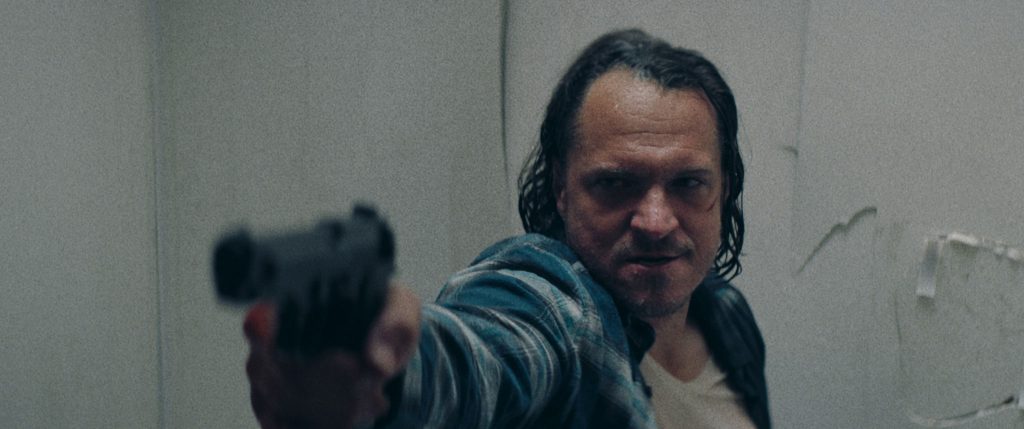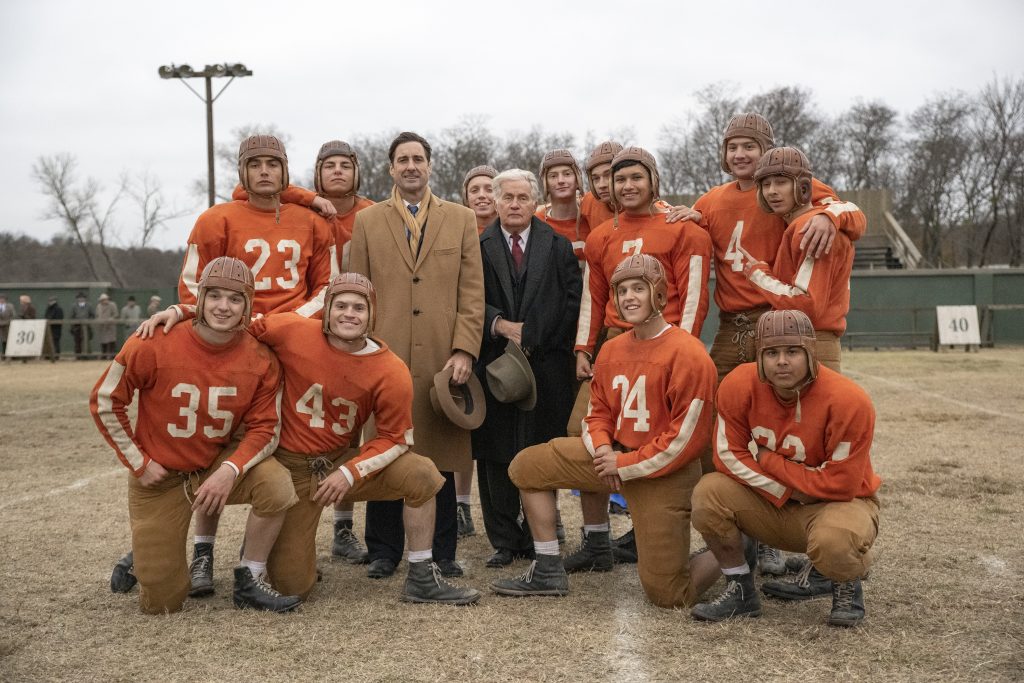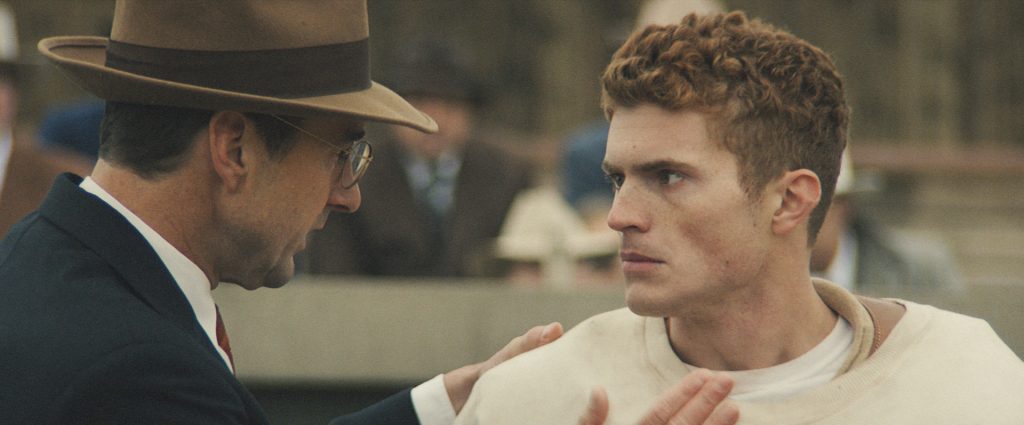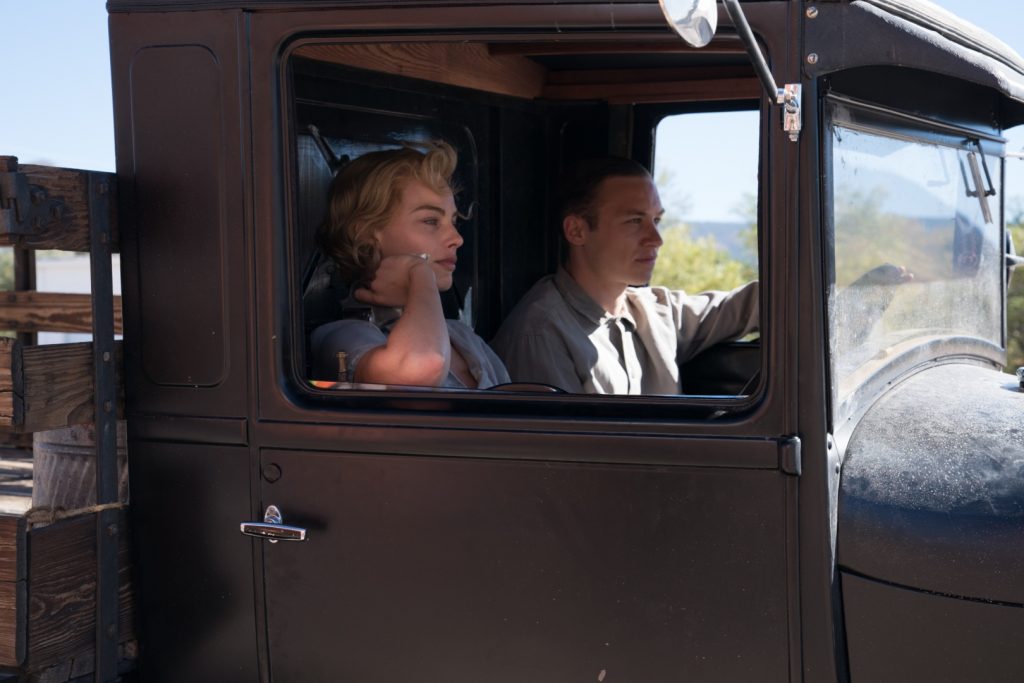July 4, 2021
by Carla Hay

Directed by Scott Windhauser
Culture Representation: Taking place primarily in El Paso, Texas, the dramatic film “Death in Texas” features a predominantly white cast of characters (with a few African Americans and Latinos) representing the working-class, middle-class, wealthy and criminal underground.
Culture Clash: A recently released ex-con finds himself returning to a life of crime so that he can get enough money to pay for his mother’s life-or-death liver transplant.
Culture Audience: “Death in Texas” will appeal primarily to people who like watching violent crime movies with badly written, unrealistic scenes.

“Death in Texas” has too many far-fetched scenarios to be taken seriously. Unfortunately, this dreadful crime drama takes itself way too seriously. There’s a lot of corny acting from experienced actors who embarrass themselves by being in this movie. And anyone who has even the slightest knowledge of organ transplants and hospitals will be cringing at the preposterous plot development in the last third of the movie.
Written and directed by Scott Windhauser, “Death in Texas” is also exceedingly tedious with its nonsensical murders that are nothing but excuses to fill this movie with violent and often-unrealistic fight scenes. The first clue that “Death in Texas” is a constant failure at realism is in the opening scene when 37-year-old prisoner Billy Walker (played by Ronnie Gene Blevins) is in a parole hearing and gets paroled in a very phony “only in a movie” moment. (“Death in Texas” takes place primarily in El Paso, Texas, but the movie was actually filmed in New Mexico.)
During the parole hearing, which has a parole board of only two people—one named Charles (played by Clark Harris) and one named Antonio (played by Daniel Steven Gonzalez)—Billy is being questioned about his rehabiltation while in prison. Billy is asked, “Do you take responsibility for your crime?” Billy replies, “As much as I can.” It’s not exactly a sign of remorse, which is a requirement to get paroled.
Billy says that he wants to be paroled so that he can take care of his mother. Charles and Antonio are not convinced that Billy has been fully rehabilitated and is ready for release. Just as they’re about to deny parole to Billy, a woman who is later revealed as parole officer Sarah Jensen (played by Veronica Burgess) suddenly appears and shows Charles and Antonio something in a file of papers. And just like that, Charles and Antonio change their minds and sign off on Billy getting parole.
Through flashbacks, the movie shows that Billy was in prison for manslaughter, and he served seven years in prison for this crime before being paroled. When his mother Grace Edwards (played by Lara Flynn Boyle) was a waitress at a diner, Billy witnessed a customer (played by Morgan Redmond) physically harassing Grace. And so, an enraged Billy beat up this man so badly that he died. The deadly assault took place in full view of other people at the diner, so there was no mystery over who committed the crime.
It’s shown many times throughout “Death in Texas” that Billy is so devoted to his mother that he will do anything for her. And yet, after Billy gets paroled, he’s shown walking by himself on a deserted highway, like a pitiful ex-con with no one who cares about him, and then showing up at Grace’s house unannounced. She seems elated and surprised to see him.
This homecoming scene doesn’t ring true, because Billy is such a mama’s boy that he would be the type to tell his mother that he was paroled, so she would be ready for him when he got released. After all, Billy has nowhere else to go but to live with his mother after getting out of prison. Considering all the extreme trouble that Billy goes through for his mother in this story, you’d think he’d tell her that he was paroled and that he needed a place to stay instead of just showing up without telling her in advance.
It’s one of many inconsistent and sloppily written scenes in the movie, which awkwardly tries to be gritty when it comes to all the criminal activities, but then attempts to be mawkishly sentimental when it comes to anything to do with Grace. Her backstory is revealed in bits and pieces of conversations in the movie. Grace gave birth to Billy when she was 15 years old, and her marriage to Billy’s father’s ended in divorce. She also got divorced from her second husband.
Soon after Billy is released from prison, Grace (who is currently a receptionist for a law firm) is having a small house party attended by her current boyfriend Todd (played by Craig Nigh), who brags to Billy about the four days that he spent incarcerated. It should come as no surprise that Billy and Todd clash immediately, and they end up having a fist fight. Grace admits to Billy that Todd is a jerk and that she has horrible taste in men. Todd is never seen again for the rest of the movie.
Grace has a much bigger problem than a tendency to get involved with losers. She needs a liver transplant, but she has rare type AB blood and can’t find a donor match. Her liver is failing not because she abused alcohol or drugs but because it might be a congenital conditon. If Grace doesn’t get the transplant, she’ll die. And what Billy does to try to solve this problem is more eye-rolling nonsense.
First, Billy goes to see Grace’s physician Dr. Perkins (played by Sam Daly) to find out what he can do to help Grace find a donor. Dr. Perkins says that he can’t reveal certain information about Grace’s condition because of doctor-patient confidentiality. And then, Dr. Perkins proceeds to violate that confidentiality and all sorts of other medical ethics by telling Billy everything private about Grace’s medical situation that Billy wants to know.
Dr. Perkins tells Billy that Grace has six months to one year to live. The doctor keeps changing this life-expectancy number to a shorter period of time the more this idiotic movie goes on, until Grace supposedly only has a few days left to live. Dr. Perkins also mentions that because Grace is so far down on a waiting list to find a donor, it’s impossible for her to get a liver in time, unless she can get a liver on the black market.
Dr. Perkins says that he knows someone in Guadalajara, Mexico, who can sell a liver for $160,000. And as a warning to Billy not to report any medical violations, the doctor tells Billy, “I’ll obviously deny that we had this conversation.” The $160,000 price tag is way beyond what Billy can afford, so it makes him desperate. Even if Billy had ever heard of legal ways to raise money for a health crisis, such as starting a crowdsourcing campaign on GoFundMe, there would be no “Death in Texas” movie if he did things legally to solve this problem.
Billy makes several attempts to find a legitimate job, but he’s rejected by every place he goes to find work because he’s an ex-con on parole. A friend of his named Kevin (played by Rocko Reyes) is a manager at a car dealership that’s owned by Kevin’s father. In a job interview, Kevin tells Billy that he would hire Billy, but Kevin’s father is the one who doesn’t want any felons working for the company.
And so, with time running out to get the money for the liver, it becomes inevitable that Billy turns to a life of crime. He decides he’ll get the money he wants by robbing other criminals. First, he targets a drug dealer named Tyler Griggs (played by Mike Foy), a former acquaintance of Billy’s, who looks and acts like a bad parody of a rapper, complete with gold teeth and a laughably horrible attempt to sound like he’s a white guy who grew up in a black ghetto.
An even bigger robbery target is a drug rehab guru named Richard Reynolds (played by Bruce Dern), a rich entrepreneur with a shady past. He currently owns a well-known drug rehab center called Reynolds Rehabilitation Ranch. Billy sees a TV news report that Reynolds Rehabilitation Ranch has received a large of amount of funding from a recent deal with El Paso General Hospital.
Through an Internet search, Billy finds out that several years ago, Reynolds was acquitted on marijuana drug smuggling charges. Billy also discovers that Reynolds has ties to a major drug cartel. And in a silly movie like “Death in Texas,” Billy decides that Reynolds will be a perfect person to rob. Never mind that Reynolds has a small squad of violent thugs who are his bodyguards and enforcers.
Meanwhile, Grace has ended up at El Paso General Hospital because her liver condition has gotten worse. One day, while she’s in her hospital room, she’s feeling so sick that she vomits on the floor. A hospital orderly comes into her room to check on her and clean up the mess. And that’s how she meets hospital orderly John Scofield (played by Stephen Lang)—their “meet cute” moment happens when he has to clean up her vomit.
Grace jokes to John that it’s “love at first sight.” He continues the flirtation, and there are romantic sparks between them. You know where this is going, of course. Just when Grace is dying, she meets someone who could be the love of her life. It’s not stated if John is divorced or widowed, but he’s definitely an available bachelor. Billy eventually meets John, and it leads to a very tacky soap opera moment that’s part of a big, heavy-handed plot twist in the movie.
Amid all the bloody carnage in the story, Billy meets a possible love interest too. Her name is Jennifer (played by Cheryl “Cher” Cosenza), who’s a street-smart bartender with a heart of gold. Tyler is also interested in her, but Jennifer thinks Tyler is a disgusting creep. Billy doesn’t have enough money to buy a liver on the black market, but he has enough money to become a regular customer at the bar where Jennifer works.
One of the worst things about “Death in Texas” is the movie’s pathetic depiction of law enforcement. Billy’s parole officer is Sarah Jensen, the same person who barged in his parole hearing to show a mystery file to the parole board. The information in that file is eventually revealed in the movie, but it’s definitely not surprising, considering what happens later in the story. The information in the file wouldn’t be enough in real life for a parole board to suddenly switch its decision to not parole someone.
Sarah’s first meeting with Billy after his release happens when she shows up at Grace’s house unannounced to interview Billy. Billy is outside, hosing down his car, because it has blood on it from a murder that he committed the night before. But this dimwitted parole officer doesn’t even notice the blood on the car when she’s talking to Billy. And throughout the story, she keeps showing up unannounced at the house, as if parole officers never make office appointments.
Even more incompetent is a homicide detective named John Wayne Asher (played by John Ashton), who is the lead investigator in the murders that Billy commits during his crime spree. Billy makes no attempt to cover his tracks, because he easily leaves his DNA and fingerprints all over his crime scenes. As a convicted felon, Billy would have his fingerprints on record and his DNA would be in the Combined DNA Index System (CODIS), which is a nationwide DNA database for convicted offenders. And yet, the dumb cops in this movie have a hard time finding out that Billy committed these crimes.
In addition to all of this idiotic portrayal of how law enforcement works, “Death in Texas” also bungles depictions of how hospitals work and what certain hospital employees would be able to do while on duty. There’s a big plot development revolving around the liver transplant part of the story that will make people groan or laugh at the stupidity of how this plot twist is handled. There’s almost nothing realistic about “Death in Texas,” except for a few conversations in the blossoming romance between Grace and John.
All of the acting in this movie veers between hokey and robotic. It’s as if no one was giving the cast members any consistent direction. And if they were given any competent direction, they certainly weren’t paying attention. Not that better acting would’ve saved this terrible movie, because “Death in Texas” was dead on arrival with its horrendously awful screenplay.
Vertical Entertainment released “Death in Texas” in select U.S. cinemas, on digital and VOD on June 4, 2021.





